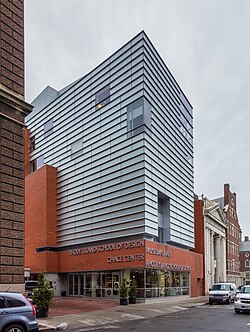Rhode Island School of Design
 From Wikipedia - Reading time: 18 min
From Wikipedia - Reading time: 18 min
 Seal of the Rhode Island School of Design | |
Other name | RISD |
|---|---|
| Type | Private art and design school |
| Established | 1877 |
| Accreditation | NECHE |
Academic affiliations | AICAD, space-grant |
| Endowment | $396 million (2023)[1] |
| President | Crystal Williams |
Academic staff | 181 full-time 421 part-time (2018–19)[2] |
| Students | 2,501 (2019–20)[2] |
| Undergraduates | 2,009 (2019–20)[2] |
| Postgraduates | 492 (2019–20)[2] |
| Location | , , United States |
| Campus | Urban 13 acres (53,000 m2) |
| Colors | RISD Blue |
| Mascot | Scrotie (unofficial) |
| Website | www |
 | |
The Rhode Island School of Design (RISD /ˈrɪzdiː/, pronounced "Riz-D"[3]) is a private art and design school in Providence, Rhode Island. The school was founded as a coeducational institution in 1877 by Helen Adelia Rowe Metcalf, who sought to increase the accessibility of design education to women.[4] Today, RISD offers bachelor's and master's degree programs across 19 majors and enrolls approximately 2,000 undergraduate and 500 graduate students.[2] The Rhode Island School of Design Museum—which houses the school's art and design collections—is one of the largest college art museums in the United States.[5]
The Rhode Island School of Design is affiliated with Brown University, whose campus sits immediately adjacent to RISD's on Providence's College Hill. The two institutions share social and community resources and since 1900 have permitted cross-registration.[6][7] Together, RISD and Brown offer dual degree programs at the graduate and undergraduate levels. As of 2024, RISD alumni have received 11 MacArthur Fellowships, 9 Emmy Awards, 7 Guggenheim Fellowships, and 3 Academy Awards.[8]
History
[edit]Founding of the school
[edit]
The Rhode Island School of Design's founding is often traced back to Helen Adelia Rowe Metcalf's 1876 visit to the Centennial Exposition in Philadelphia. At the exposition, Metcalf visited the Women's Pavilion. Organized by the "Centennial Women," the pavilion showcased the work of female entrepreneurs, artists, and designers.[9][10] Metcalf's visit to the pavilion profoundly impacted her and motivated her to address a deficiency in design education accessible to women.
Following the exhibition, the RI committee of the Centennial Women had $1,675 remaining in funds; the group spent some time negotiating how best to use the surplus.[11] Metcalf lobbied the group to use the money to establish a coeducational, design school in Providence. On January 11, 1877, a majority of women on the committee voted for Metcalf's proposal.[10]

On March 22, 1877, the Rhode Island General Assembly ratified "An Act to Incorporate the Rhode Island School of Design", "[f]or the purpose of aiding in the cultivation of the arts of design". Over the next 129 years, the following original by-laws set forth these following primary objectives:[12]

- The instruction of artisans in drawing, painting, modeling, and designing, that they may successfully apply the principles of Art to the requirements of trade and manufacture.
- The systematic training of students in the practice of Art, in order that they may understand its principles, give instruction to others, or become artists.
- The general advancement of public Art Education, by the exhibition of works of Art and of Art school studies, and by lectures on Art.
Metcalf directed the school until her death in 1895. Her daughter, Eliza Greene Metcalf Radeke, then took over until her own death in 1931.[13]
Beginnings
[edit]The school opened in October 1877 in Providence. The first class consisted of 43 students, the majority of whom were women.[10][14]
For the first 15 years of its existence, RISD occupied a suite of six rooms on the fourth floor of the Hoppin Homestead Building in Downtown Providence. On October 24, 1893, the school dedicated a new brick building at 11 Waterman Street on College Hill. Designed by Hoppin, Read & Hoppin, this building served as the first permanent home for the school.[15]
Activism during the Vietnam War
[edit]Students at RISD played a key part in the national protest of the Vietnam War, producing various notable anti-war protest art from 1968–1973 and taking several on tour as part of a mobile artwork petition. The most well known is Leave the Fear of Red to Horned Beasts, a reference to Victor Hugo novel Les Misérables in the form of a watercolor-on-canvas painting of a charging red bull. An original print of this painting is on permanent display at the War Remnants Museum in Ho Chi Minh City, Vietnam in a section dedicated to international protest of the Vietnam War, and also features subtly as a bar mural in the Vietnam War film Point Man.
In 1969 the Black Student Community of RISD published a manifesto demanding of university faculty the establishment of "a meaningful liaison with the spirit and expression of Black culture."[16] RISD subsequently hired administrators to begin recruiting and admitting increased numbers of students of color.
COVID-19
[edit]After the outbreak of COVID-19 and the subsequent closure of the RISD campus in March 2020,[17] RISD suggested a future of a hybrid of classes online and in-person.[18]
In July 2020, President Somerson began negotiations with the RISD faculty union over the avoidance of possible layoffs by suggesting cost-cutting measures.[19] The part-time faculty union, the National Education Association, rejected the initial proposal.[19]
Racial diversity and equity
[edit]In the summer of 2020, after the Black Lives Matter and George Floyd protests, RISD students and alumni came forward to voice outrage at the institution for failing at social equity and inclusion.[20][21] They formed a student-led RISD Anti-Racism Coalition (ARC) alongside BIPOC faculty.[20][21] As a result, in July 2020, RISD announced they would hire 10 new faculty members that would specialize in "race and ethnicity in arts and design", the RISD museum would return to Nigeria a sculpture that was once looted, expand and diversify the curriculum, and the school would, "remain committed to reform".[20][22]
Labor strike
[edit]
In April 2023, after months of negotiations, the RISD employees union held a picket line protest in demand of better wages. The union, which represents custodians, groundskeepers and movers, was joined in the strike by student supporters and community members.[23][24] The strike lasted two weeks, until workers approved a new contract and returned to work April 19.[25]
Pro-Palestine solidarity
[edit]Some students at RISD, along with many across the country in the BDS movement, occupied a campus building for multiple days in support of a cease-fire of the Israeli–Palestinian conflict in early May 2024.[26]
Presidents
[edit]RISD's current president is Crystal Williams. She was preceded by Rosanne Somerson who served in the role from 2015 to 2021.[27]
Rankings and admission
[edit]In 2014, U.S. News & World Report ranked RISD first amongst fine arts programs nationwide.[28] In 2020, graduate programs in Graphic Design, Painting, Sculpture, and Photography, among others, were ranked in the top 5 nationally, however, in 2023, RISD announced its withdrawal from the rankings, citing its inability to accurately assess art and design education, while also running counter to principles of social equity and inclusion.[29][30] The school's undergraduate architecture program ranked 6 in DesignIntelligence's ranking of the Top Architecture Schools in the US for 2019.[31] In 2018, the institution was also named among Forbes' America's Top Colleges[32] and the Chronicle of Higher Education's Top Producers of US Fulbright Scholars.[33]
RISD's acceptance rate is 13.8% (2024).[34] In August 2019, the school announced it would be adopting a test-optional policy for admissions.[35]
Campus
[edit]
In the past, RISD buildings were mostly located at the western edge of College Hill, between the Brown University campus and the Providence River. In recent decades, RISD has acquired or built buildings on the downslope nearer the river, or in Downtown Providence just on the other side of the waterway. The main library, undergrad dormitories, and graduate studios of the college are now located downtown.[36]: 21 [37]
RISD Museum
[edit]
The RISD Museum was founded in 1877 on the belief that art, artists, and the institutions that support them play pivotal roles in promoting broad civic engagement and creating more open societies. With a permanent collection numbering approximately 100,000 works, the RISD museum is the third largest art museum attached to an educational facility.[38][39]
Athletics
[edit]RISD has many athletic clubs and teams.[40] The hockey team is called the "Nads", and their cheer is "Go Nads!"[41] The logo for the Nads features a horizontal hockey stick with two hockey pucks at the end of the stick's handle.
The basketball team is known simply as "The Balls", and their slogan is, "When the heat is on, the Balls stick together!"[41][42] The Balls' logo consists of two balls next to one another in an irregularly shaped net.[43]
Lest the sexual innuendo of these team names and logos be lost or dismissed, the 2001 creation of the school's unofficial mascot, Scrotie, ended any ambiguity. Despite the name, Scrotie is not merely a representation of a scrotum, but is a 7-foot tall penis.[44]
The school's color is a vivid blue.[45]
Notable people
[edit]Alumni
[edit]Notable RISD alumni include Kara Walker (MFA 1994),[46] Jenny Holzer (MFA 1977),[47] Nicole Eisenman (BFA 1987),[48] Do-Ho Suh (BFA 1994),[49] Julie Mehretu (MFA 1997),[50] Roni Horn (BFA 1975), Shahzia Sikander (MFA 1995), Sam Hyde (BFA 2007), Glenn Ligon (attended 1978–80),[51] Ryan Trecartin (BFA 2004),[52] Lizzie Fitch (BFA 2004),[52] Janine Antoni (MFA 1989),[53] Rose B. Simpson (MFA 2011)[54] as well as artist collectives including Fort Thunder (1995–2001) and Forcefield (1997–2003) and the band Lightning Bolt. Graduates in photography include Francesca Woodman (BFA 1978),[55] Todd Hido (attended 1991–92),[56] Deana Lawson (MFA 2004),[57] and RaMell Ross (MFA 2014).[58]
Among the school's alumni in illustration are Brian Selznick (BFA 1988),[59] Chris Van Allsburg (MA 1975), Roz Chast (BFA 1977), and David Macaulay (BArch 1969).[60] Alumni in graphic design include Shepard Fairey (BFA 1992),[61] Tobias Frere-Jones (BFA 1992),[62] and Pippin Frisbie-Calder (BFA 2008).[63] Among the alumni of the school's architecture department are Hashim Sarkis (BArch 1987)[64] Deborah Berke (BFA 1975, BArch 1977),[65] Preston Scott Cohen (BArch 1983),[66] and Nader Tehrani (BArch 1986).[67]
Prominent RISD graduates in film include James Franco (MFA 2012),[68] Seth MacFarlane (BFA 1995),[69] Jemima Kirke (BFA 2008),[70] Bryan Konietzko (BFA 1998),[71] Michael Dante DiMartino (BFA 1996),[71] Gus Van Sant (BFA 1975),[72] and Robert Richardson (BFA 1979).[73] Graduates in music include bassist Syd Butler (BFA 1996) and two founding members of Talking Heads: Tina Weymouth (BFA 1974) and Chris Frantz (BFA 1974);[74] Talking Heads' other founder, David Byrne, is also a RISD alumnus and met Weymouth and Frantz at the art school, but left before graduation.
Among the school's alumni in business are Airbnb co-founders Joe Gebbia (BFA 2004) and Brian Chesky (BFA 2004).[75][76]
-
Glass sculptor Dale Chihuly (MFA 1968)
-
Talking Heads lead singer David Byrne (1970–71)
-
Filmmaker Gus Van Sant (BFA 1975)
-
Contemporary installation artist Do-Ho Suh (BFA 1994)
-
Avatar: The Last Airbender co-creator Michael Dante DiMartino (BFA 1996)
-
Avatar: The Last Airbender co-creator Bryan Konietzko (BFA 1998)
-
Contemporary artist Kara Walker (MFA 1994)
-
Contemporary painter Julie Mehretu (MFA 1997)
-
CEO and co-founder of Airbnb, Brian Chesky (BFA 2004)
-
Co-founder of Airbnb, Joe Gebbia (BFA 2005)
-
Artist and comedian Sam Hyde (BFA 2007)
-
Actor and filmmaker James Franco (MFA 2012)
Faculty
[edit]Notable RISD faculty include photographers Diane Arbus, Aaron Siskind, and Elle Pérez, sculptor Simone Leigh, painters Jennifer Packer, Aaron Gilbert, and Angela Dufresne, architect Friedrich St. Florian, designers Victor Papanek and Pierre Kleykamp, and Pulitzer Prize-winning author Jhumpa Lahiri.[77][78][79][80][81] Rockwell King DuMoulin was a professor and architecture department chair from 1972 to 1978.[82]
References
[edit]- ^ As of June 30, 2023. RISD Endowment (Report). Rhode Island School of Design. June 30, 2023. Retrieved September 30, 2024.
- ^ a b c d e "About". Rhode Island School of Design. Archived from the original on February 18, 2020. Retrieved January 6, 2020.
- ^ "Chace Center/RISD Museum". Rhode Island Art In Ruins. 20 August 2009. Archived from the original on 2022-02-07. Retrieved 2022-02-07.
- ^ "RHODE ISLAND SCHOOL OF DESIGN". Supply Rhode Island. Archived from the original on 2020-06-16. Retrieved 2020-04-22.
- ^ Ganesh, Preeti (2020-01-30). "RISD Museum collection expands with 33 gifted works from collectors". Brown Daily Herald. Archived from the original on 2021-05-02. Retrieved 2021-05-02.
- ^ University, Brown (1900). Annual Report of the President to the Corporation of Brown University. Archived from the original on 2021-10-28. Retrieved 2021-05-02.
- ^ "RISD + Brown". Archived from the original on 2019-04-02. Retrieved 2019-05-08.
- ^ "Prestigious National and International Awards | RISD Alumni". alumni.risd.edu. Archived from the original on 2022-01-15. Retrieved 2022-01-15.
- ^ Austin, Nancy. "Towards a Genealogy of Visual Culture at the Rhode Island School of Design, 1875–1900". Dissertation, Brown University. Ann Arbor: ProQuest/UMI, 2009. (Publication No. 3370099.)
- ^ a b c Grzyb, Frank L.; DeSimone, Russell J. (2014-07-22). Remarkable Women of Rhode Island. Arcadia Publishing. ISBN 978-1-62585-069-0. Archived from the original on 2022-06-29. Retrieved 2020-10-28.
- ^ Austin, Nancy. "What a Beginning is Worth". Infinite Radius. Ed. Dawn Barrett and Andrew Martinez. (Providence: Rhode Island School of Design, 2008) 170–196.
- ^ Austin, Nancy. "No Honors to Divide". Infinite Radius. Ed. Dawn Barrett and Andrew Martinez. (Providence: Rhode Island School of Design, 2008) 197–217.
- ^ Kirk, Laura Meade (2004-03-21). "From bonnets to baccalaureates". The Providence Journal. Archived from the original on 2011-06-29. Retrieved 2007-10-17.
- ^ Austin, Nancy (2009). "3: A Place for Design: RISD at the Hoppin Homestead, 1878–1893". Towards a Genealogy of Culture at the Rhode Island Schoolof Design, 1876–1896 (PhD). Brown University. Archived from the original on 2022-06-29. Retrieved 2020-09-29.
- ^ "Infinite Radius: Founding Rhode Island School of Design | Archives | Rhode Island School of Design". digitalcommons.risd.edu. Archived from the original on 2020-10-27. Retrieved 2020-09-29.
- ^ "Statement of Belief" (PDF). Archived from the original (PDF) on 2022-06-29.
- ^ Borg, Linda (March 16, 2020). "RISD becoming blank canvas as students leave". ProvidenceJournal.com. Archived from the original on 2020-07-02. Retrieved 2020-07-06.
- ^ Borg, Linda (June 16, 2020). "RISD plans hybrid of in-person and online instruction". ProvidenceJournal.com. Archived from the original on 2020-07-05. Retrieved 2020-07-06.
- ^ a b Borg, Linda (July 1, 2020). "RISD president: 'We are continuing to have conversations to avoid layoffs'". ProvidenceJournal.com. Archived from the original on 2020-07-07. Retrieved 2020-07-06.
- ^ a b c Fitzpatrick, Edward (July 21, 2020). "Responding to activism, RISD is hiring faculty, boosting diversity, returning looted artifacts". The Boston Globe. Archived from the original on 2020-08-12. Retrieved 2020-08-10.
- ^ a b "Rhode Island School of Design releases open letter promising social equity action". The Architect's Newspaper. 2020-07-27. Archived from the original on 2020-08-08. Retrieved 2020-08-10.
- ^ "RISD announces plans to focus on social equity and inclusion in art and design education". Archinect. Archived from the original on 2020-08-22. Retrieved 2020-08-10.
- ^ Fish, Kayla (7 April 2023). "RISD students join union workers as strike continues". WPRI. Nexstar Media. Archived from the original on 9 April 2023. Retrieved 13 April 2023.
- ^ Klein, Kristine (11 April 2023). "Students and faculty at RISD express support for groundskeepers, movers, and custodial staff on strike". The Architect's Newspaper. Archived from the original on 11 April 2023. Retrieved 13 April 2023.
- ^ "RISD Strike Ends with Contract Agreement". ArtForum. April 18, 2023. Retrieved 20 July 2023.
- ^ Perry, Jack. "RISD occupation ends after school president threatens expulsion. Here's what happened". The Providence Journal. Retrieved 2024-05-11.
- ^ Villa, Angelica (2021-12-16). "Crystal Williams Becomes First Black Leader of RISD, One of the Nation's Oldest Art Schools". ARTnews.com. Archived from the original on 2022-03-06. Retrieved 2022-03-06.
- ^ "Rhode Island School of Design | RISD | Best College | US News". Colleges.usnews.rankingsandreviews.com. Archived from the original on 2015-03-03. Retrieved 2015-03-06.
- ^ "Rhode Island School of Design's Graduate School Rankings". Archived from the original on 2023-05-15.
- ^ "Rhode Island School of Design Withdraws from U.S. News & World Report's Annual Rankings | RISD". www.risd.edu. 2023-02-13. Retrieved 2024-03-23.
- ^ "The Best Architecture Schools in the U.S. 2019". 3 September 2016. Archived from the original on 19 April 2019. Retrieved 10 June 2019.
- ^ "Forbes – America's Top Colleges". Forbes. Archived from the original on 2020-06-18. Retrieved 2019-06-10.
- ^ "Brown, RISD again among top Fulbright producers". Providence Business News. February 21, 2018. Archived from the original on April 23, 2020. Retrieved June 10, 2019.
- ^ "Rhode Island School of Design Admissions".
- ^ Borg, Linda. "RISD to drop SAT, ACT as admissions requirements". providencejournal.com. Archived from the original on 2021-04-23. Retrieved 2021-01-30.
- ^ Selected works. Providence Rhode Island, US: Museum of Art, Rhode Island School of Design. 2008. ISBN 978-0911517828.
- ^ "Campus Map" (PDF). RISD. Archived (PDF) from the original on 2022-01-08. Retrieved 2022-02-07.
- ^ Ganesh, Preeti (2020-01-30). "RISD Museum collection expands with 33 gifted works from collectors". Brown Daily Herald. Archived from the original on 2021-05-02. Retrieved 2021-05-30.
- ^ Stamp, Elizabeth (31 August 2015). "The Best University Art Museums in America". Architectural Digest. Archived from the original on 2021-06-02. Retrieved 2021-05-30.
- ^ "RISD Clubs and Organizations". Archived from the original on 2022-06-29. Retrieved 2019-05-08.
- ^ a b "10 Weirdest College Mascots – RISD mascot, university mascot". Archived from the original on 2017-12-27. Retrieved 2018-04-28.
- ^ Zeigler, Cyd (11 July 2012). "Rhode Island School of Design students love their Nads and Balls". Outsports. Archived from the original on 28 April 2018. Retrieved 28 April 2018.
- ^ Molinari, Jessica (6 February 2014). "Scrotie The Penis & More Wacky College Mascots". Bustle. Archived from the original on 2018-04-28. Retrieved 2018-04-28.
- ^ "The Story Of Scrotie, The College Sports Mascot Who Was A Dick And Balls". 22 September 2016. Archived from the original on 28 April 2018. Retrieved 28 April 2018.
- ^ "How We Look". Rhode Island School of Design Visual Identity. Rhode Island School of Design. Retrieved 2022-09-29.
- ^ "Kara Walker | Biography, Art, & Facts". Encyclopedia Britannica. Archived from the original on 2020-08-13. Retrieved 2020-09-14.
- ^ Jenny Holzer Archived 2012-02-03 at the Wayback Machine Tate Collection, London.
- ^ "Biography of Nicole Eisenman – Susanne Vielmetter, Los Angeles Projects". vielmetter.com. Archived from the original on 13 May 2019. Retrieved 21 September 2015.
- ^ "Do Ho Suh – Artists – Lehmann Maupin". www.lehmannmaupin.com. Archived from the original on 2019-03-21. Retrieved 2019-03-21.
- ^ Calvin Tomkins (March 29, 2010). "Big Art, Big Money: Julie Mehretu's 'Mural' for Goldman Sachs Archived 2010-03-26 at the Wayback Machine". The New Yorker. Retrieved 2017-08-04.
- ^ "The Writing on the Wall: Glenn Ligon on Borrowing Text to Expose American Racism, in 2011". ARTnews.com. 2016-01-15. Archived from the original on 2021-11-22. Retrieved 2021-11-22.
- ^ a b "Lizzie Fitch/Ryan Trecartin – Artists – Regen Projects". www.regenprojects.com. Retrieved 2024-04-22.
- ^ "About". Janine Antoni. Retrieved 2024-05-11.
- ^ "Rose B. Simpson | CV | Jessica Silverman Gallery". jessicasilvermangallery.com. Retrieved 2024-05-11.
- ^ Post, Kyle MacMillian | The Denver (2006-12-14). "Francesca Woodman's haunting vision". The Denver Post. Archived from the original on 2021-03-07. Retrieved 2020-09-14.
- ^ "A Haunting View of Suburbia | BU Today". Boston University. Archived from the original on 2022-06-29. Retrieved 2021-03-18.
- ^ "Profile". Princeton University. Archived from the original on 2017-05-04. Retrieved 2017-05-04.
- ^ "RaMell Ross MFA '14". RISD Photo. Retrieved 2024-03-23.
- ^ "Selznick, Brian 1966– | Encyclopedia.com". www.encyclopedia.com. Archived from the original on 2021-06-02. Retrieved 2021-05-30.
- ^ "The Way Macaulay Thinks". www.risd.edu. Archived from the original on 2018-07-20. Retrieved 2021-03-18.
- ^ List, Madeleine. "Providence welcomes back renowned street artist Shepard Fairey". providencejournal.com. Archived from the original on 2020-10-30. Retrieved 2020-09-14.
- ^ Consuegra, David (2011-10-10). Classic Typefaces: American Type and Type Designers. Simon and Schuster. ISBN 978-1-62153-582-9. Archived from the original on 2022-06-29. Retrieved 2020-09-14.
- ^ "Pippin Frisbie-Calder". Joan Mitchell Foundation. October 2021. Retrieved October 1, 2024.
- ^ "Hashim Sarkis named curator of 2020 Venice Biennale Architecture Exhibition". MIT News | Massachusetts Institute of Technology. 19 December 2018. Archived from the original on 2021-06-02. Retrieved 2021-05-30.
- ^ "Deborah Berke, FAIA". Interior Design. Retrieved 2020-09-14.[permanent dead link]
- ^ Architecture (CCA), Canadian Centre for. "Preston Scott Cohen Eyebeam project records". www.cca.qc.ca. Archived from the original on 2021-01-18. Retrieved 2020-09-14.
- ^ "Nader Tehrani | The Cooper Union". cooper.edu. Archived from the original on 2020-09-26. Retrieved 2020-09-14.
- ^ Ellin, Abby (2012-04-13). "Failure Is Not an Option". The New York Times. ISSN 0362-4331. Archived from the original on 2021-06-03. Retrieved 2021-05-30.
- ^ Lenburg, Jeff (2006). Who's who in Animated Cartoons: An International Guide to Film & Television's Award-winning and Legendary Animators. Hal Leonard Corporation. ISBN 978-1-55783-671-7. Archived from the original on 2022-06-29. Retrieved 2020-10-28.
- ^ Laster, Paul (2017-12-12). "Jemima Kirke, Painter of Brides, Thinks There's One Good Excuse to Get Married". Garage. Archived from the original on 2021-06-02. Retrieved 2021-05-30.
- ^ a b "Nickelodeon Establishes Avatar Studios, Brand-New Content Division Devoted to Expanding the World of Avatar: The Last Airbender and The Legend of Korra". Paramount Global. February 21, 2021. Retrieved January 11, 2024.
- ^ "Filmmaker Gus Van Sant has always been a painter at heart". Time Out New York. 11 October 2019. Archived from the original on 2020-10-26. Retrieved 2020-09-14.
- ^ "Interview with Robert Richardson, ASC". Global Cinematography Institute. Archived from the original on 2022-03-02. Retrieved 2020-09-14.
- ^ Cutler, Jacqueline (17 July 2020). "Talking Heads drummer doesn't miss a beat chronicling a life in rock and roll". nydailynews.com. Archived from the original on 2021-01-05. Retrieved 2021-03-18.
- ^ "Forbes Billionaires 2020". Forbes. Archived from the original on 2019-01-04. Retrieved 2020-09-14.
- ^ Busulwa, Richard; Birdthistle, Naomi; Dunn, Steve (2020-01-29). Startup Accelerators: A Field Guide. John Wiley & Sons. ISBN 978-1-119-63859-9. Archived from the original on 2022-06-29. Retrieved 2020-10-28.
- ^ "Diane Arbus". International Center of Photography. 2019-03-17. Archived from the original on 2021-01-22. Retrieved 2021-01-30.
- ^ "No Fear of Failure". Our RISD. 22 April 2015. Archived from the original on 2021-02-03. Retrieved 2021-01-30.
- ^ Neumann, Friedrich St Florian and Dietrich. "St. Florian and Neumann: Let's dare to change Providence's skyline". providencejournal.com. Archived from the original on 2021-02-04. Retrieved 2021-01-30.
- ^ "Victor Papanek". Oxford Reference. Archived from the original on 2022-06-29. Retrieved 2021-03-18.
- ^ "Lahiri, Jhumpa | Encyclopedia.com". www.encyclopedia.com. Archived from the original on 2021-04-30. Retrieved 2021-01-30.
- ^ "Rockwell K. DuMoulin". The New York Times. 1983-02-18. ISSN 0362-4331. Retrieved 2023-10-14.
 KSF
KSF











